For Valentine’s Day, we have a tale not so much of love, but of supernatural seduction. This is the story of a chaste young woman of the town of Dunwich stalked by a devil, as reported in The Life and Miracles of St. William of Norwich by Thomas of Monmouth. We also take a look at real and fictional Dunwich (a town of the Lovecraft mythos featured in “The Dunwich Horror”), and examine what exactly (or inexactly) an incubus was thought to be.
Today’s Text:
- The Life and Miracles of St. William of Norwich, written by Thomas of Monmouth and translated by Augustus Jessopp and M.R. James. Cambridge UP, 1896. [Available on Google Books.]
References:
- Bryant B.L. “H. P. Lovecraft’s ‘Unnamable’ Middle Ages.” Medieval Afterlives in Popular Culture, edited by Gail Ashton and Dan Kline, Palgrave Macmillan, 2012, pp. 113-128.
- Isidore of Seville. The Etymologies of Isidore of Seville. Translated by Stephen A. Barney, W.J. Lewis, J.A. Beach, and Oliver Berghof with Muriel Hall, Cambridge UP, 2006.
- van der Lugt, Maaike. “The Incubus in Scholastic Debate: Medicine, Theology, and Popular Belief.” Religion and Medicine in the Middle Ages, edited by Peter Biller and Joseph Ziegler, Boydell & Brewer, 2001, pp. 175-200.
Image: Poster for The Dunwich Horror (1970)
We kick our 2019 with a return to narrative history, hearing about a terrible way to die and how not to profit off the deaths of others during a plague from William of Malmesbury’s Gesta Regum Anglorum, and we also look all the way back to the first book of Samuel to learn how to rid oneself of some particularly uncomfortable plagues from God. We also discover how Raiders of the Lost Ark should have ended.
Today’s Texts:
- William of Malmesbury. Chronicle of the Kings of England. Edited by J.A. Giles, translated by John Sharpe and J.A. Giles, George Bell & Sons, 1895. Google Books.
- Wycliffe, John and John Purvey. Wycliffe’s Bible: A Modern-Spelling Version of the 14th-Century Middle English Translation. Edited and translated by Terence P. Noble, Createspace, 2012.
References:
- Drummond, David. Mouse Traps: A Quick Scamper through their Long History. North American Trap Collectors Association, 2005.
- Farber, Zev. “Unspoken Hemorrhoids: Making the Torah Reading Polite.” TheTorah.com,https://thetorah.com/unspoken-hemorrhoids-making-the-torah-reading-polite/.
- Kiser, Lisa J. “Resident Aliens: The Literary Ecology of Medieval Mice.” Truth and Tales: Cultural Mobility and Medieval Media, edited by Fiona Somerset and Nicholas Watson, Ohio State UP, 2015, pp. 151-167. Academia.edu, www.academia.edu/11171687/Resident_Aliens_The_Literary_Ecology_of_Medieval_Mice.
Image: Detail of an illustration of the plague of mice afflicting the Philistines (1 Samuel 5) from Morgan Library MS M.638 fol. 21v (13th cent.)
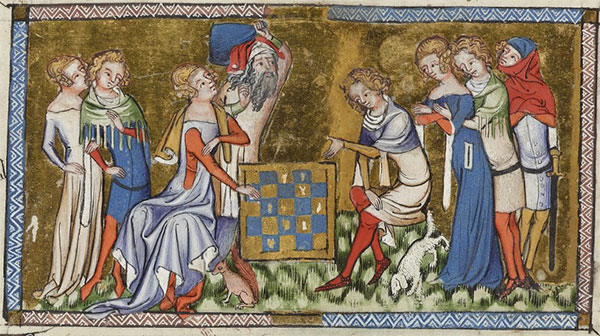
In this final episode in our holiday chess series, we finish off the last pages in William Caxton’s
The Game and Playe of the Chesse, looking at the pawn and the importance of the common people to the realm, and we consider the how to explain pawns becoming queens in a medieval context.
Today’s Texts:
- Caxton, William. The Game and Playe of the Chesse. Edited by Jenny Adams, TEAMS Middle English Text Series, U of Rochester, 2009.
- Axon, William E.A. Introduction. Caxton’s Game and Play of the Chesse, Elliot Stock, 1883, pp. ix-lxxii. Google Books.
- Murray, H.J.R. A History of Chess. Clarendon Press, 1913.
References:
- Crist, Walter, et al. “Facilitating Interaction: Board Games as Social Lubricants in the Ancient Near East.” Oxford Journal of Archaeology, vol. 35, no. 2, May 2016, pp. 179–196. EBSCOhost, doi:10.1111/ojoa.12084.
- Eales, Richard. “Changing Cultures: The Reception of Chess into Western Europe in the Middle Ages.” Ancient Board Games in Perspective: Papers from the 1990 British Museum Colloquium, With Additional Contributions, edited by I.L. Finkel, British Museum Press, 2007, pp. 162-168.
- Finkel, Irving L. “Board Games in Perspective: An Introduction,” Ancient Board Games in Perspective: Papers from the 1990 British Museum Colloquium, With Additional Contributions, edited by I.L. Finkel, British Museum Press, 2007, pp. 1-4.
Image: Detail from Vows of the Peacock, Morgan Library MS G.24, fols. 25v
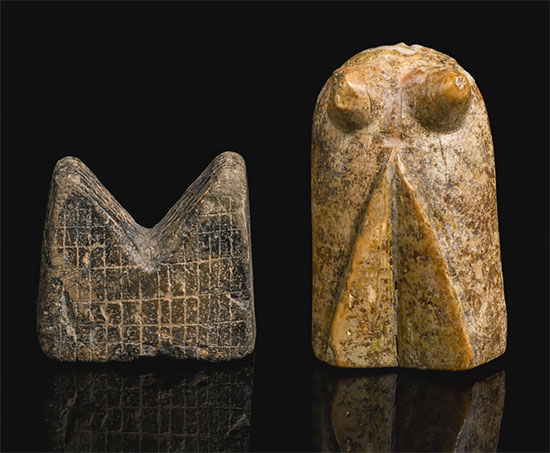
This fourth installment of our holiday chess series finishes off the back rank of pieces: the bishop (or alphyn), the knight, and the rook. We also explore a long-standing Wikipedia beef over
rook terminology, and recommend a modern board game that plunges you into the paranoid world of zombie survival.
Today’s Text:
References:
- Eales, Richard. “Changing Cultures: The Reception of Chess into Western Europe in the Middle Ages.” Ancient Board Games in Perspective: Papers from the 1990 British Museum Colloquium, With Additional Contributions, edited by I.L. Finkel, British Museum Press, 2007, pp. 162-168.
- Murray, H.J.R. A History of Chess. Clarendon Press, 1913.
Image: Abstract 12th-century rook (left) and bishop/al-fin (right) from Sotheby’s Arts of the Islamic World Auction (20 April 2016), Lot 101.
Sources for embedded chapter images:
- Early bishops, knight, and rook: Sotheby’s Arts of the Islamic World Auction (20 April 2016), Lots 100 and 101. http://www.sothebys.com/en/auctions/2016/arts-islamic-world-l16220.html
- Later bishop: http://ancientchess.com/page/play-courier-chess.htm & https://www.zafiyashop.xyz/vintage-chess-c-1_204_205_298/antique-vintage-wooden-st-george-black-bishop-chess-piece-spare-p-3500.html
- Later bishop/rook comparison: https://www.jstor.org/stable/41694919?seq=1#page_scan_tab_contents
- Dowel pieces: http://www.chess-museum.com/regency-chess-sets.html
- Staunton pieces: https://en.wikipedia.org/wiki/Staunton_chess_set#/media/File:JaquesCookStaunton.jpg
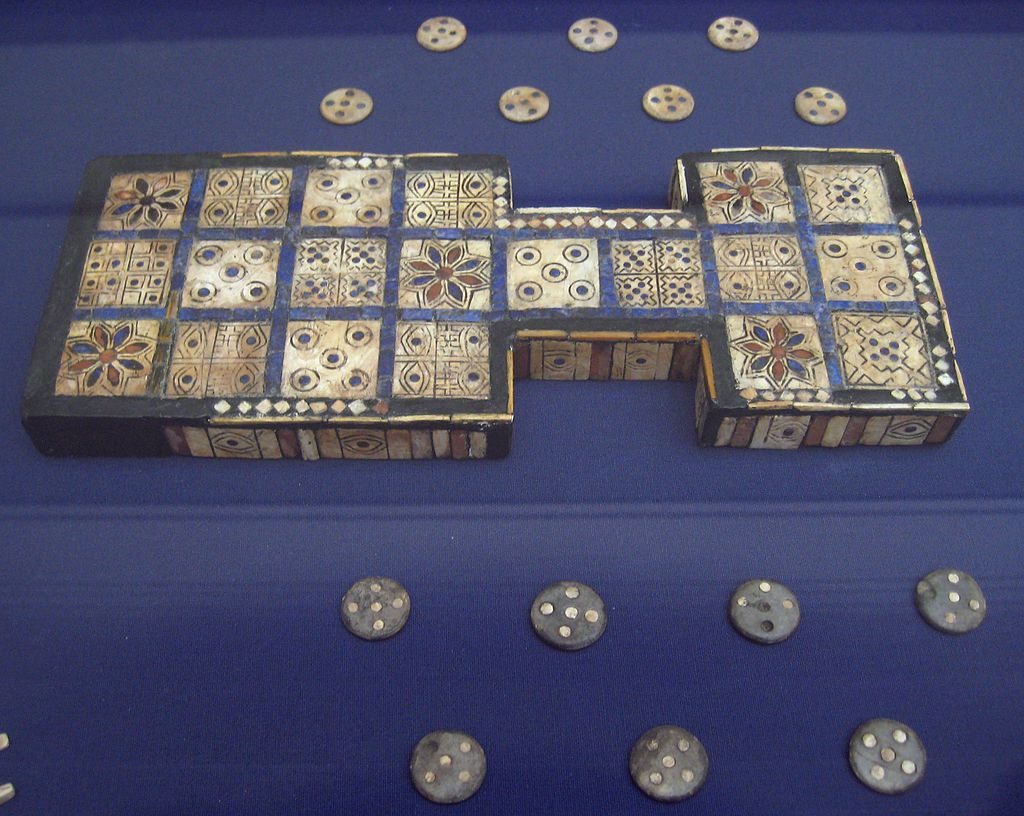
In the third episode of our holiday series of excerpts from William Caxton’s
The Game and Playe of the Chesse, we learn about how the king and queen move, which was a bit different in the 15th century than it is today. We also consider the difficulty of working out the rules of an ancient game, even when you have the remarkable fortune to find them written down, as seen in the case of the Royal Game of Ur.
Today’s Text
- Caxton, William. The Game and Playe of the Chesse. Edited by Jenny Adams, TEAMS Middle English Text Series, U of Rochester, 2009, http://d.lib.rochester.edu/teams/publication/adams-caxton-game-and-playe-of-the-chesse.
- Finkel, Irving L. “On the Rules for the Royal Game of Ur.” Ancient Board Games in Perspective: Papers from the 1990 British Museum Colloquium, With Additional Contributions, edited by I.L. Finkel, British Museum Press, 2007, pp. 16-32.
References
- Becker, Andrea. “The Royal Game of Ur.” Ancient Board Games in Perspective: Papers from the 1990 British Museum Colloquium, With Additional Contributions, edited by I.L. Finkel, British Museum Press, 2007, pp. 11-15.
- Eales, Richard. “Changing Cultures: The Reception of Chess into Western Europe in the Middle Ages.” Ancient Board Games in Perspective: Papers from the 1990 British Museum Colloquium, With Additional Contributions, edited by I.L. Finkel, British Museum Press, 2007, pp. 162-168.
- Murray, H.J.R. A History of Chess. Clarendon Press, 1913.
- Murray, H.J.R. A History of Board-Games Other Than Chess. Clarendon Press, 1952.
Image: Board and pieces for the Royal Game of Ur, displayed at the British Museum (via Wikimedia Commons)
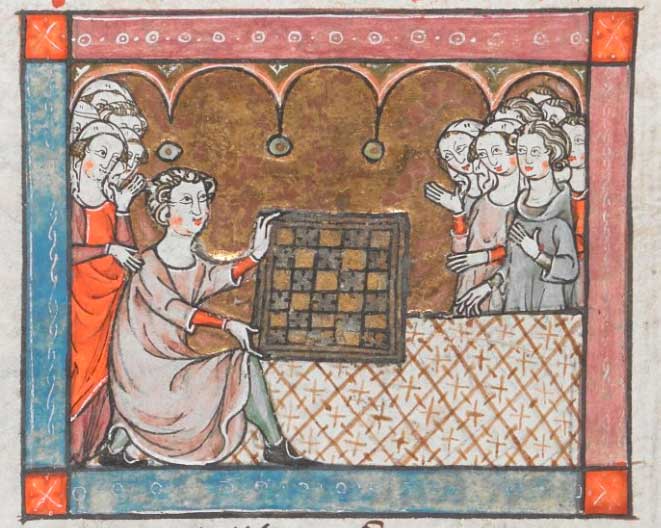
In this second installment of our holiday series of excerpts from William Caxton’s
The Game and Playe of the Chesse, we hear about the layout of the chessboard and what it represents. We also look at some of the games that chess replaced in Europe, including the Roman
ludus latrunculorum, the Celtic
fidchell or
gwyddbwyell, and the Norse
tafl or
hnefatafl. And finally, we consider different ways in which the board of a board game might be constituted.
Today’s Text
References
- Eales, Richard. “Changing Cultures: The Reception of Chess into Western Europe in the Middle Ages.” Ancient Board Games in Perspective: Papers from the 1990 British Museum Colloquium, With Additional Contributions, edited by I.L. Finkel, British Museum Press, 2007, pp. 162-168.
- Murray, H.J.R. A History of Board-Games Other Than Chess. Clarendon Press, 1952.
Image: Detail of Lancelot receiving an enchanted chessboard from British Library Add. MS. 10293 f. 302r.
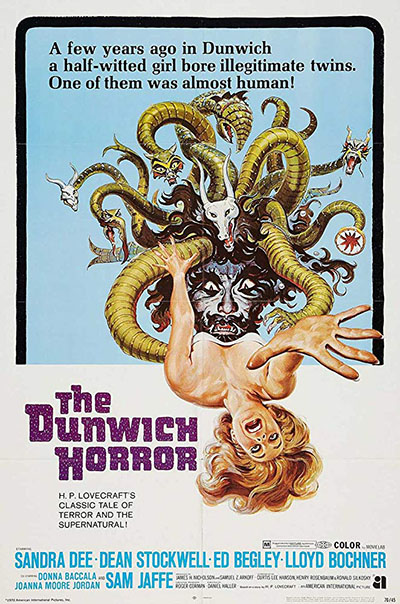
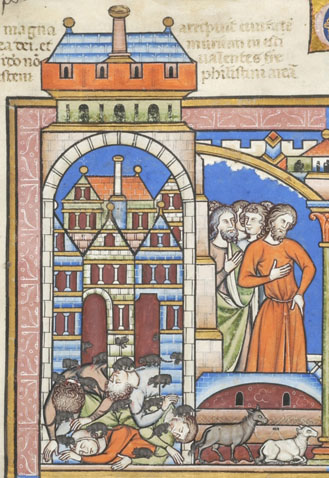







Recent Comments